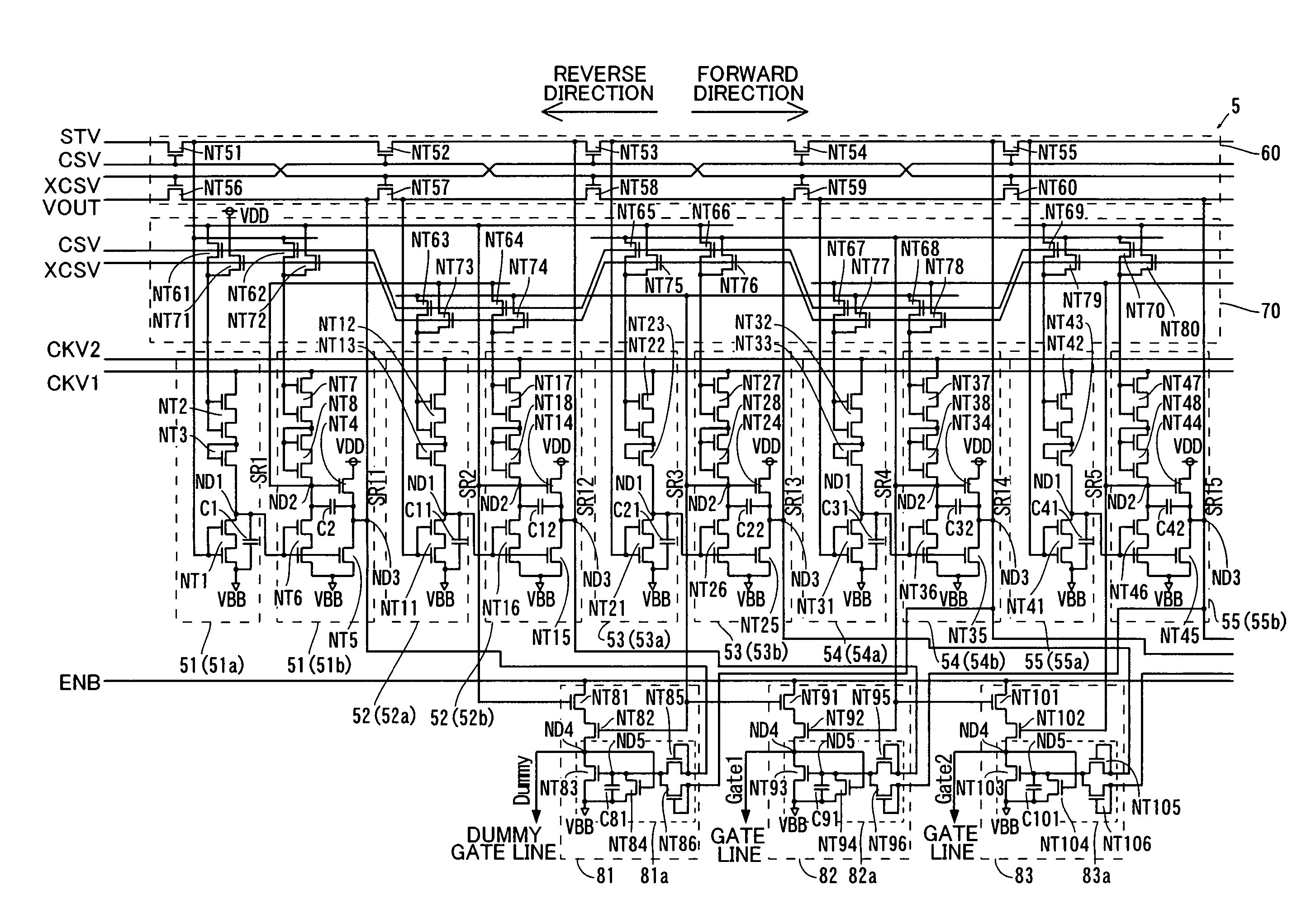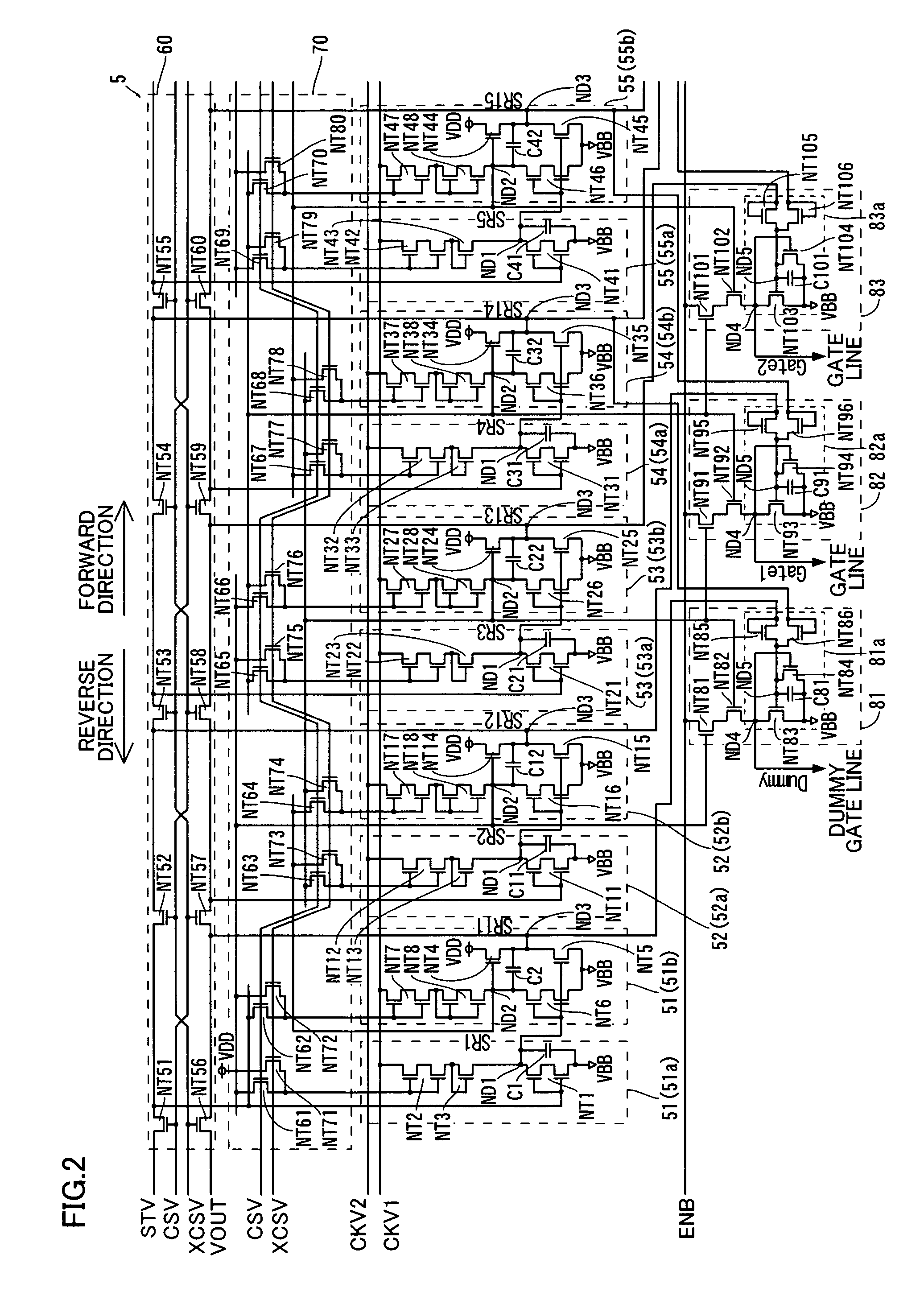Display
a display and display technology, applied in the field of display, can solve the problems of disadvantageous increase in power consumption of vdd and vss, disadvantageous increase in power consumption of liquid crystal display or organic el display, etc., and achieve the effect of suppressing the increase of power consumption
- Summary
- Abstract
- Description
- Claims
- Application Information
AI Technical Summary
Benefits of technology
Problems solved by technology
Method used
Image
Examples
first embodiment
[0042]Referring to FIG. 1, a display portion 2 is provided on a substrate 1 in a liquid crystal display according to a first embodiment of the present invention. On this display portion 2, pixels 20 are arranged in the form of a matrix. FIG. 1 shows only one pixel 20, in order to simplify the illustration. Each pixel 20 is constituted of an n-channel transistor 21 (hereinafter referred to as a transistor 21), a pixel electrode 22, a common electrode 23, common to the respective pixels 20, opposed to the pixel electrode 22, a liquid crystal 24 held between the pixel electrode 22 and the common electrode 23 and a subsidiary capacitor 25. The source of the transistor 21 is connected to the pixel electrode 22 and the subsidiary capacitor 25, and the drain thereof is connected to a drain line. The gate of this transistor 21 is connected to a gate line.
[0043]Horizontal switches (HSW) 3 and an H driver 4 for driving (scanning) drain lines of the display portion 2 are provided on the substr...
second embodiment
[0134]Referring to FIGS. 4 and 5, a V driver 5a similar to the V driver 5 according to the aforementioned first embodiment is constituted of p-channel transistors in a liquid crystal display according to a second embodiment of the present invention.
[0135]Referring to FIG. 4, a display portion 2a is provided on a substrate 1a in the liquid crystal display according to the second embodiment. On this display portion 2a, pixels 20a are arranged in the form of a matrix. FIG. 4 shows only one pixel 20a, in order to simplify the illustration. Each pixel 20a is constituted of a p-channel transistor 21a (hereinafter referred to as a transistor 21a), a pixel electrode 22a, a common electrode 23a, common to the respective pixels 20a, opposed to the pixel electrode 22a, a liquid crystal 24a held between the pixel electrode 22a and the common electrode 23a and a subsidiary capacitor 25a. The source of the transistor 21a is connected to a drain line, and the drain thereof is connected to the pixe...
third embodiment
[0140]Referring to FIG. 7, a liquid crystal display according to a third embodiment of the present invention supplies an enable signal to the drains of transistors connected to nodes, outputting shift output signals, of third-stage and subsequent shift register circuit portions in place of a higher voltage in a structure similar to that of the aforementioned first embodiment.
[0141]According to the third embodiment, the liquid crystal display is provided with a plurality of stages of shift register circuit portions 511 to 515, a scanning direction switching circuit portion 610, an input signal switching circuit portion 710 and a plurality of logic composition circuit portions 811 to 813, as shown in FIG. 7. While FIG. 7 shows only five stages of shift register circuit portions 511 to 515 and three stages of logic composition circuit portions 811 to 813 in order to simplify the illustration, the shift register circuit portions and the logic composition circuit portions are provided in...
PUM
 Login to View More
Login to View More Abstract
Description
Claims
Application Information
 Login to View More
Login to View More - R&D
- Intellectual Property
- Life Sciences
- Materials
- Tech Scout
- Unparalleled Data Quality
- Higher Quality Content
- 60% Fewer Hallucinations
Browse by: Latest US Patents, China's latest patents, Technical Efficacy Thesaurus, Application Domain, Technology Topic, Popular Technical Reports.
© 2025 PatSnap. All rights reserved.Legal|Privacy policy|Modern Slavery Act Transparency Statement|Sitemap|About US| Contact US: help@patsnap.com



